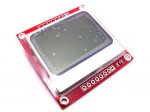LCD Displays
I use LCD displays in many of my projects. The "standard" or most widely used LCD is a 2 line by 16 character alphanumeric display with a parallel interface to the processor, and a HD44780 controller. It is readily available and inexpensive. (PIC Example, AVR Example). This type of display comes in many flavors, typically from 1 to 4 lines and from 8 to 40 characters. It is simple to interface with your microprocessor if you have enough I/O ports available (only 4 of 8 data lines are needed) and either compilers provide support for them or libraries are available. You specify the port names you use and the number of rows and columns, usually in a header file. This display always has a 14 or 16 pin interface, 14 pins for the display and 2 more pins if there is a backlight.
Another kind of LCD display I have used has no decoder built in, and you have to drive each segment of each character yourself (much like an LED display). This example uses a simple, cheap 3 digit display, the Lumex LCD-S301C31TR (DigiKey 67-1788-ND). The advantage is low cost and power consumption. The disadvantage is the need for lots of I/O lines, and no backlight. Bigger displays with more digits are available, but some kind of decoder or multiplexer must be used. Also the display is static, and requires periodic polarity reversal or else it fades out. A good write-up on the subject can be found here.
Then there is the KTM-S1201, a 12-digit mostly numeric display, which I have documented on a separate page here. Update.
I stumbled across an interesting and inexpensive graphical display in
2012/04, the Nokia 5110. It is 48 x 84 pixels, and the support code
from the seller included a small alphanumeric font giving 14 characters
and 6 rows, and a large numeric font giving 7 numbers and 2 rows.
Power is limited to 2.7 to 3.3 Volt range. One vendor is Sparkfun, and the price was US$9.95. They may be available from other vendors,
with various support code that is mainly Arduino based. My first
project using this display was a clock
using an ATmega88 and no RTC chip. The display is serial accessed,
using the AVR's SPI port and 3 other control lines (plus backlight).
Update.
I stumbled across an interesting and inexpensive graphical display in
2012/04, the Nokia 5110. It is 48 x 84 pixels, and the support code
from the seller included a small alphanumeric font giving 14 characters
and 6 rows, and a large numeric font giving 7 numbers and 2 rows.
Power is limited to 2.7 to 3.3 Volt range. One vendor is Sparkfun, and the price was US$9.95. They may be available from other vendors,
with various support code that is mainly Arduino based. My first
project using this display was a clock
using an ATmega88 and no RTC chip. The display is serial accessed,
using the AVR's SPI port and 3 other control lines (plus backlight).